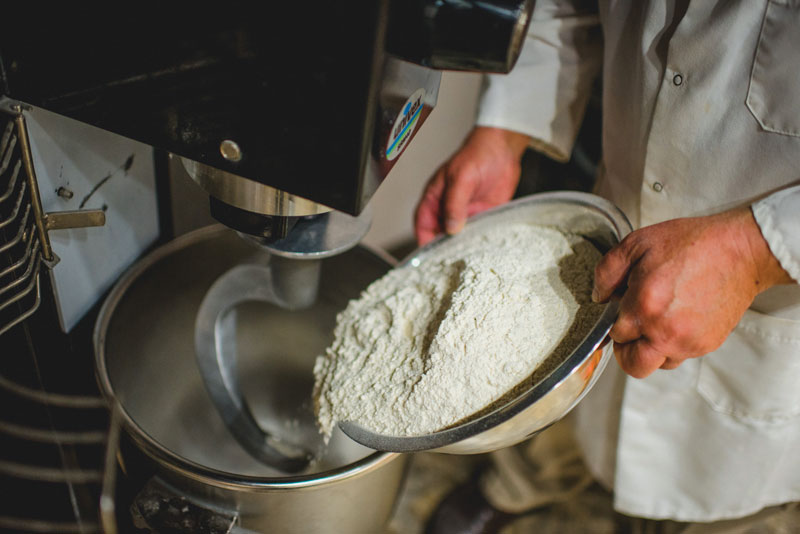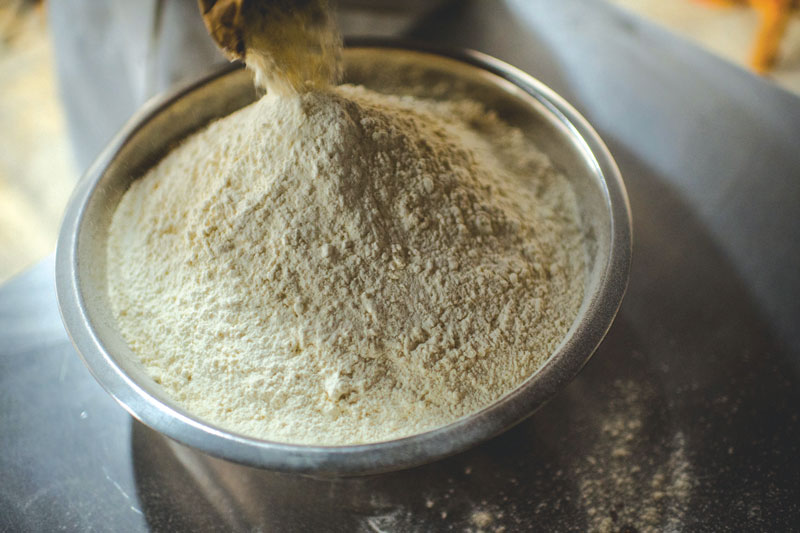Flour is a key ingredient in pizza making, but it’s probably also the least understood—and definitely the most underappreciated. Flour is fundamental to our pizza recipes, yet it’s mysterious and constantly changing. As a food scientist who specializes in dough, I find it endlessly fascinating, but to a lot of pizzeria operators who just want to make consistently delicious pizza, it can be downright confounding. Fortunately, decades of research have yielded fairly simple solutions to these mysteries, so let’s put on our Sherlock Holmes hat and give them a closer look.
Managing Dough Absorption
I tell pizza makers that there is a big difference between flour and hockey pucks. Hockey pucks are always exactly the same, while flour is constantly changing in some significant—or even minute—manner. That’s because wheat breeders continually make modifications to their cultivars to achieve specific desired traits (insect or fungus resistance, yield, protein content, drought resistance, and milling and baking properties, just to name a few). These cultivars keep evolving, literally changing every year or two, which means that the grist (wheat that’s blended at the flour mill to make a specific flour) keeps changing, too.
Fortunately, flour millers do a spectacular job of evening out the many fluctuations in the final product, providing flour with consistent and predictable performance traits. But variations are unavoidable, and one of the most significant relates to total absorption. If you’ve wondered why your dough doesn’t quite feel right since your latest batch of flour came in, these subtle changes in your flour might explain it.
Many pizzeria operators never make any changes to the amount of water they add to their dough. They follow the exact same formula for years. But your actual flour absorption rate is changing, and you may need to account for it. Commercial operations (commissaries and bakeries) receive a Farinograph report that describes these changes in absorption. But pizzeria operators don’t get such data with their bagged flour. Not to worry, though. Just keep in mind that the flour can and will change in absorption properties from time to time, and it is correct to adjust the amount of water added to the dough in response to these normal variations. So if your latest batch of dough feels a little different since your last flour delivery, don’t be afraid to make slight (2%) incremental changes in dough absorption to get your dough handling properties back on track.
—Tom Lehmann
Gluten vs. Protein Content
The gluten content of flour is another point of confusion for some pizza makers. In fact, flour doesn’t contain any gluten at all, regardless of what the bag might say. Instead, the flour contains two groups of proteins (glutenin and gliadin) which, when agitated in water, form the sticky, cohesive material that we call “gluten.”
So how do we know the real strength of a specific flour if the words “high gluten” don’t tell the whole story? The answer is to look at the flour’s protein content. While not an absolute indicator of flour strength, it is a very good way to assess the relative potential strength of various flours. This is why I tend to reference flour according to a specific protein range rather than by high, medium or low gluten content. If your flour’s protein content isn’t listed on the bag, look for the information on the brand’s website.
Say Goodbye to Bromated Flour
Bromated vs. nonbromated flour is another issue that comes up regularly. At one time, most flours were bromated to some extent, but, due to health concerns, only a few flours are bromated today. I don’t recall ever seeing any pizzeria or dough commissary operation that truly needed bromated flour. At one time, back when the dough was bulk-fermented, as opposed to being formed into smaller individual dough balls for fermentation, a bromated flour exhibited great performance characteristics. But if you ball your dough for storage (cold fermentation)—the usual practice these days—I seriously doubt you will see any advantage in using a bromated flour. If you do see a difference, take a close look at your dough management procedure. I’ll bet you can find ways to address the problems without the need for bromate or any other dough additive.

Incorporating Organic Flour
|
5 Facts About Flour |
| By Liz Barrett
Working with flour is both a science and an art. So we asked one food scientist and two pizza artists to share a few must-know tips, and here’s what they told us: 1 If you’re freezing your dough, use a flour with a higher protein content. It will help the dough last longer. —Tom Lehmann 2 If you freeze flour for 30 days and then move it to the fridge, it can last for years as long as you keep it stored in the refrigerator. —Tom Lehmann 3 Despite feeling dry, flour can actually be about 15% water. However, this can vary by a few points. So if you have a recipe that calls for 62% hydration and a particular batch of flour has just 13% water rather than its normal 15%, your recipe can be off by those 2 points. You have to be flexible and use your experience to look at the texture of the dough. Flour is a natural product and can vary just like any of your produce. —Jeff Varasano, Varasano’s Pizzeria, Atlanta 4 Flour can have a shelf life up to one year if stored in a 60° to 70°F environment free of excessive humidity. Three months is the recommended storage time unless refrigerated. —Tom Lehmann 5 You can get a more natural rise in your dough with a small amount of yeast. I recommend using 2 grams of yeast, 1 liter of water, and 50 grams of salt in 1.7 kg. of flour. —Roberto Caporuscio, Kesté Pizza & Vino and Don Antonio by Starita, New York, N.Y. |
Organic flour gets a lot of attention these days, since many pizzerias want to serve what is perceived as more consumer-friendly, healthier pizza. Organic flour is nothing more than flour milled from wheat that has been certified as “organic.” Such flours are grown, handled and stored according to specific guidelines, then milled in the usual manner—but without any additives, such as malted barley flour (malt), additional vitamins and minerals for enrichment, or oxidants (i.e., azodicarbonamide, ascorbic acid or bromate).
So is there a trick to keep in mind for incorporating organic flour into your dough recipe? For the most part, regular pizza flour and organic flour can be substituted for each other, providing they each have a similar protein content (most organic flours seem to have a protein content of around 12%, but be sure to confirm this with the manufacturer). The one thing to keep in mind is that organic flour lacks malt. Without malt, the flour cannot readily produce its own sugars to support yeast activity over a period of several days. However, you can address this problem by simply adding sugar to your dough formulation or adding some diastatic (enzyme-active) malt to the dough. If you already add sugar to your dough anyway, as many of you do, you’re set to go!













